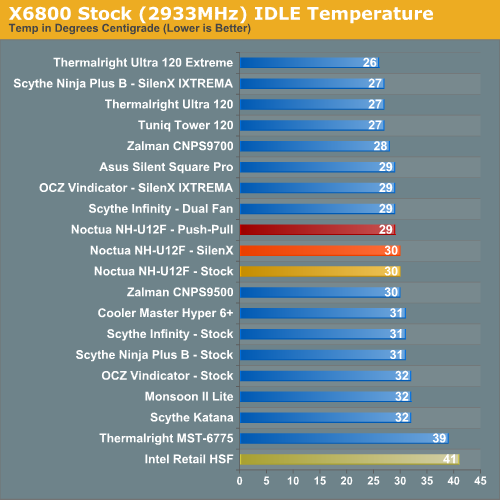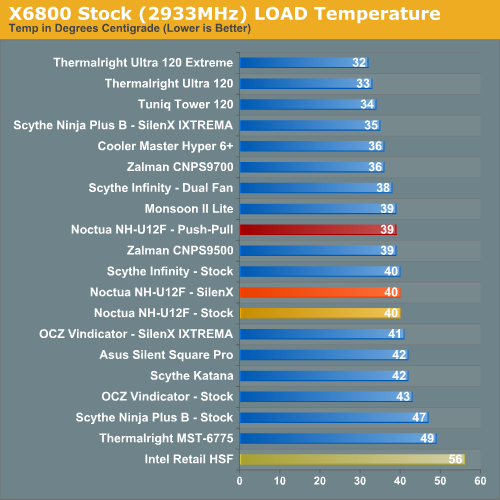Noctua NH-U12F: Quiet Air Cooling from Austria
by Wesley Fink on April 25, 2007 4:00 AM EST- Posted in
- Cases/Cooling/PSUs
Cooling at Stock Speed
Some users will never overclock their CPU, but they still want to run the coolest CPU temperatures possible to enhance stability and extend CPU life. The Noctua NH-U12F comes complete as a kit with a low noise Noctua fan, so stock speed tests were run with the stock Noctua fan. Cooling results are also reported with two Noctua fans in a push-pull configuration and with a SilenX high-output fan.
Where the very good Intel stock cooler keeps the X6800 at 41C at idle, the Noctua manages 30C. The SilenX high-output fan achieves the same results at stock idle, which was a bit of a surprise considering the rated difference in fan output. The best Noctua results were with a push-pull fan configuration at 29C. The Thermalright coolers at the top of our heatpipe tower performance charts cool to 26C. The Noctua is obviously not the best stock idle cooler we have tested, but it is broadly competitive within this group.
It is more difficult to effectively simulate a computer being stressed by all of the conditions it might be exposed to in different operating environments. For most home users CPU power is most taxed with contemporary gaming. Therefore our stress test simulates running a demanding contemporary game. The Far Cry River demo is looped for 30 minutes and the CPU temperature is captured at 4 second intervals with the NVIDIA monitor "logging" option. The highest temperature during the load test is then reported. Momentary spikes are ignored, as we report a sustained high-level temp that you would expect to find in this recording configuration.
Cooling efficiency of the Noctua NH-U12F was compared under load conditions at stock speed to the retail HSF and other recently tested CPU coolers.

The NH-U12F under load at stock speeds reached a maximum temperature of 40C in both stock and SilenX configurations. Best performance was with a push-pull fan configuration at 39C. This compares to the Thermalrights at 32C and 33C, the Tuniq at 34C and the Cooler Master Hyper 6+ and Zalman 9700 at 36C. Stock load performance is average among tested coolers.










30 Comments
View All Comments
HeatMiser - Thursday, April 26, 2007 - link
Wes -- how far does this Noctua cooler hang over the edge of the motherboard closest to the Power supply? Just trying to figure out if I have room. Thanks for the great reviews on these coolers.Bumtrinket - Friday, May 4, 2007 - link
It largely depends on the motherboard - if the CPU socket is close to the top edge, you could have problems if there's not much space between the mobo and PSU. This also applies to the Thermalright Ultra 120 and other similar designs. The design of the heatsink mounting lets you rotate it through 90 degrees, but that's not the preferred orientation.There's more info at Noctua's site, but they say this in the FAQs:
"How much space between mainboard and power supply is required when the NH-U12 is installed upright?"
"When installed upright (see picture below), the NH-U12 may jut out over the upper edge of the mainboard. In this case, the gap required between the upper edge of the mainboard and the power supply in the case is (depending on the position of the CPU socket on the mainboard) up to 25mm. Measured from the upper mounting holes of the CPU socket, the required distance to the power supply unit is 35mm."
n7 - Wednesday, April 25, 2007 - link
I am a big fan of Noctua, so nice to see their heatsink do as well as i expected.Their fans are very good @ providing a mix of performance & realtive quietness, & it appears this heatsink is no different.
I too would really like to see a TT Big Typhoon added to the reviews, mainly to see how it does compared to the new leaders, something the Typhoon used to be.
I also look forward to seeing your testbed redone with a quieter PSU.
TA152H - Wednesday, April 25, 2007 - link
OK, I read this article with some interest, and as usual find the remarks about fanless power supplies completely off-base.I mean, if you're measuring overclocking a CPU, or some high end gaming system, or some high-end Peltier cooler, I could see the point in not using a fanless power supply because such a power supply wouldn't be useful in that configuration. But, I don't buy power supplies with fans anymore, and guess what type of heatsink I go after when I buy them? Yes, very quiet ones. So, when you're testing a heatsink/fan that is made to be especially quiet, or for example, fanless video cards, you SHOULD test with a fanless power supply.
I know most of the reviewers here think shooting space aliens is what everyone does, and they need 600 watt power supplies, but it's just not true. Most people in fact don't need anything that large, so try to think within the market of the product instead of personal preferences. I'm not knocking video games, by the way, they are a much better escape than drugs, or other bad things people do, or even TV. I'm just saying that you guys need to stop thinking everyone does this and needs equipment to handle these foul machines, especially when reviewing items that would never be put in one.
customcoms - Wednesday, April 25, 2007 - link
I agree that in order to get more accurate noise ratings a more quiet system based on a fanless psu would achieve higher accuracy. However, anandtech tests have generally catered to enthusiasts and overclockers, and imo, these tests do that well. For starters, they compare cooling performance with noise as a secondary consideration (mainly to see if the cooler advertised is quiet, but as it sates in the article, they are more curious about its cooling/overclocking ability than the noise). Yes, anandtech is using what could be considered a "noisy" test bed, but X6800's and 7900GTX's don't exactly come to mind when I think "silent" pc. Nor do the power, hungry, hot Nvidia 680i based boards. I suggest looking elsewhere for reviews on components that make up silent pc's, such as http://www.silentpcreview.com">http://www.silentpcreview.com. I'll stick with anandtech's review because I could care less about noise if it lets me gain an extra 300mhz out of my processor.TA152H - Wednesday, April 25, 2007 - link
Then why review a heatsink that is focused on being quiet? You completely missed the point. I don't have a problem with them reviewing noisy items, but you don't review a heatsink/fan that is made to be especially quiet, with a noisy power supply or video card. If the heatsink were a cooling beast that didn't pay much mind to noise problems, absolutely go with appropriate stuff. People that want it will not care about noise with the other components. But when someone is considering getting a unit because it is quiet, you don't use a noisy baseline because that same person is likely to look for that same quality in their other components.Ajax9000 - Wednesday, April 25, 2007 - link
Agreed.The "proper" (but time consuming :-) thing to do would be to have a "performance" testbed (which is also investigated for noise as a secondary test), and a "silent" testbed (which is also investigated for overclockability as a secondary test). I.e. people who want "quiet" systems don't automatically excude overclocking, they are just less concerned about it (and vice versa).
Paradox999 - Wednesday, April 25, 2007 - link
Great review and comparison.As an owner of a Scythe Ninja equipped with a silent fan, I can attest to it's effectiveness.....but your batch of reviewed HSF's is missing my personal favorite, the Thermaltake Big Typhoon. It's one of the best at cooling nearby capacitors since the fan blows DOWNWARDS onto the motherboard. I've replaced the original fans for some slower and silent Silenx fans since the core2duo isn't as hot as my old overclocked 820D.
Works awesome good.
Do us all a favor and please include the Big Typhoon (and not it's weaker cousin, the Mini Typhoon) in your review
Spanki - Wednesday, April 25, 2007 - link
I couldn't get my comments posted in here, so I added them as http://forums.anandtech.com/messageview.aspx?catid...">a new thread in the forums.Deusfaux - Wednesday, April 25, 2007 - link
"We also ran brief test results comparing the cooling efficiency and noise of the Scythe SFLEX SFF21F 64cfm/28 dB-A fan that was used in Thermalright reviews and the SilenX fan used in several of the most recent reviews. Cooling results were similar with either fan on the Noctua heatsink, with the SilenX providing better cooling on some overclocks. Both fans were quiet and came in below the noise floor of our test system, but the SilenX was subjectively quieter than the SFLEX. "REALLY. I have trouble believing this, but I guess we'll find out for sure in the upcoming roundup.